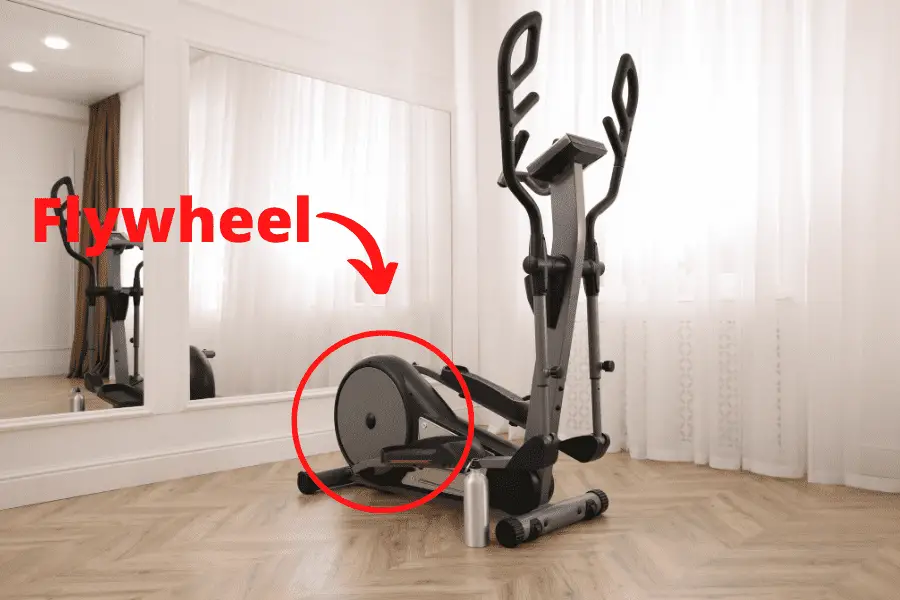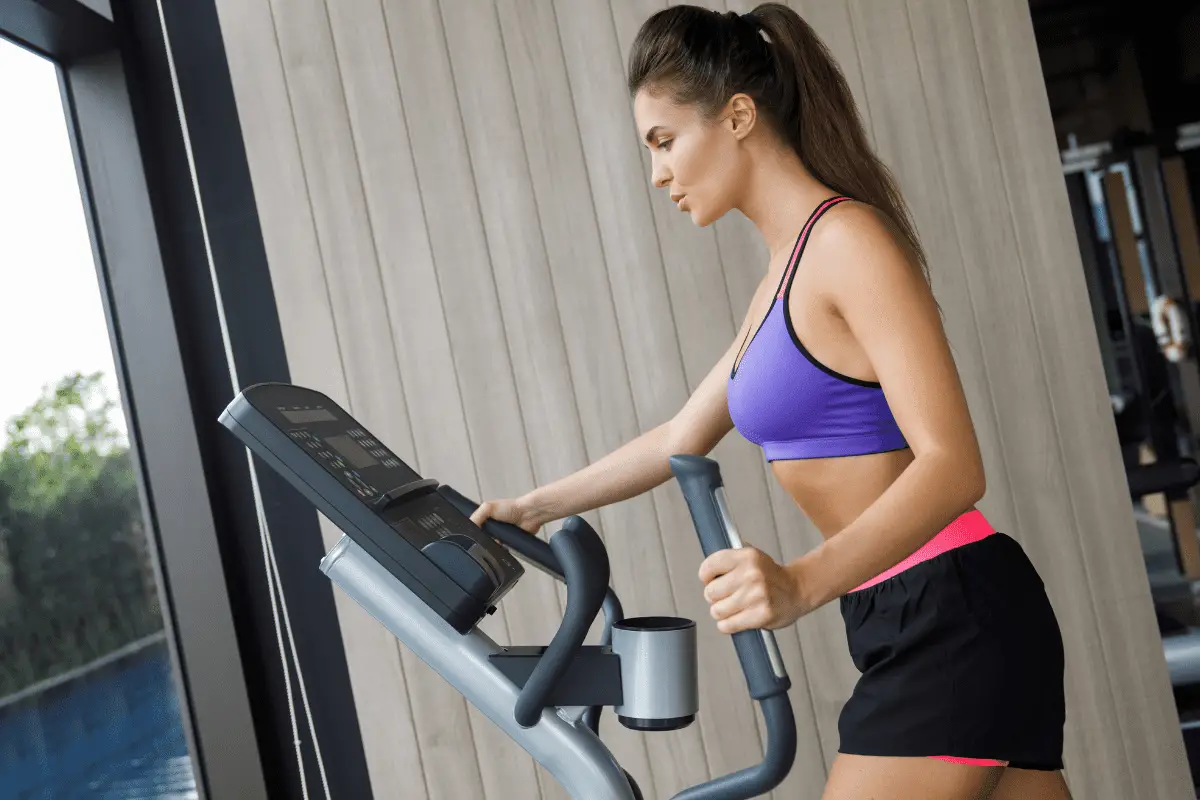Elliptical trainers come in two different setups. What are those different setups, what do they do differently and should you care when shopping for one? Let’s find out.
Front or rear drive refers to the location of the flywheel in an elliptical trainer. Front drive models tend to be cheaper and smaller but the movement pattern doesn’t generally feel as natural as rear drive elliptical. Rear flywheel elliptical trainers tend to be longer and more expensive.
What are the exact differences in theory and practice between those two models and should you go out of your way to buy one or the other? You’ll find that and more below.
Contents
Differences between front and rear flywheel elliptical trainers?

It’s pretty simple really, elliptical machines have a flywheel. The flywheel is a big disk that spins when you move the pedals and levers. You can’t put that disk in the middle of the machine because that’s where the exerciser is standing.
That leaves putting the flywheel in the front or the rear of the machine. Front or rear drive just refers to the location of the flywheel. If the flywheel is located in the front, it’s called front drive and if the flywheel is in the rear, it’s called rear drive.
On some of the low end model, you can see the actual flywheel because it’s exposed to see. On higher end models the disc might be contained in a plastic shroud so you can’t actually see it. However, usually you’ll only have one side with plastic shrouds so you can still easily see where the flywheel is.
Another way to see if it’s a front or rear drive model is the place where the pedals are connected to the machine. Just check where the pedals are connected to the inside of the machine. If it’s the rear, it’s rear drive, if it’s in the front, it’s obviously front drive.
You might think that that difference shouldn’t really matter. However, there are a surprising amount of differences between the two architectures. The location of the flywheel is just a design decision a manufacturer can make but as a result of that, the two types of machine do differ in some key aspects. Of course they’re both still elliptical trainers but let’s find out what the differences are.
Pros and cons of front drive ellipticals?
Let’s take a look at the pros and cons of So a front drive elliptical trainer has the flywheel in the front. What are the pros and cons of this design?
Pros
- Usually smaller dimensions
- Usually cheaper
- Higher possible incline settings (if applicable)
Cons
- Has more moving parts
- Noisier
- More maintenance
- Movement pattern doesn’t feel as natural
Especially the cheaper models don’t feel as smooth as you would want them to. If you’re used to a commercial grade elliptical trainer in the gym, a cheap front drive won’t give you the same experience.
There is a wide range of front drive models and they look and feel quite a bit different. The cheapest models are pretty much exclusively front drive. They’re cheaper to produce and are smaller so this makes them cheaper to sell.

How big is an elliptical trainer?
Those ellipticals have a set of drawbacks that are more a result of them being low end models than being front drive. The smoothness of motion, motion pattern and noise production are some of those things.
There are also more and more high end models that are front wheel drive. Those models have much fewer of the drawbacks named above. The feel of these models will be much closer to rear drive units although there are still some differences. Because they are smaller to package, front drive models are good for home gyms that have limited space. That’s why some high end manufacturers are making this type of elliptical trainer with really high quality.
Many front flywheel ellipticals have some kind of slide rail. This means the front of the pedals is connected to the flywheel while the rear slides/rolls on a rail. This requires more maintenance to keep the motion smooth. It also means that there tends to be more up and down movement in every stride. This makes it feel more like walking upstairs or uphill.
This isn’t necessarily a bad thing. This will work the back of your legs a little bit more which can result in more muscle growth in the glutes, hamstrings and calves. If you’re not looking for a trainer that replicated running but just a good workout, this is actually a benefit.
Which muscles does an elliptical trainer target?
Suggested post: Do elliptical trainers have incline?
Front drive elliptical trainers are best for people who want a good cardio workout, train their leg muscles and are looking for a smaller and/or cheaper elliptical machine. Their smaller size makes front drive ellipticals especially suitable for home gyms.
Recommended front drive elliptical trainer
What are the pros and cons of rear drive cross trainers?
Now let’s look at the pros and cons of a rear drive elliptical trainer.
Pros
- Closer to running outside
- Fewer moving parts than front drive
- Less noise
- Less maintenance
Cons
- Usually in higher price ranges
- Longer so take up more space
This setup tends to make machines significantly bigger than front drive ones. Many of them are also more expensive than front drive models. On the plus side, the movement of these machines is flatter/more natural. It feels more like running outside or on a treadmill. That is a big benefit for many people.
This is the type you’ll often see in a commercial gym or health club.

These machines also tend to feel a bit smoother but that is partly also a result of these trainers being more expensive.
Many people also feel they are a bit more upright on rear drive models. Finally, rear drive models tend to have longer stride lengths. Stride length is quite important and has to be suitable for your height. Read here which stride length is right for you.
In general, rear drive models are for more advanced exercisers who want the best experience they can get and have plenty of space in their home gym.
Is a front or rear drive crosstrainer best for you?
Now you know the differences, but maybe you still aren’t sure if a front or rear drive elliptical is best for you.
What’s best for you depends on your goals and expectations. You can see the pros and cons of both types above so if there is something specific you’re looking for, it’ll be clear to you which type you should look for.
If you’re still not sure, let’s look at two examples to make it a bit clearer.
- A: Beginner, casual exerciser, looking for a good cardio workout, doesn’t want to spend too much money, has limited space.
- B: Intermediate/advanced exerciser, works out almost every day, is willing to spend some money, has plenty of space.
Suggested: How much does an elliptical trainer cost?
Person A would be best served by a cheaper front drive model. Front drive models are a bit cheaper to produce so you’re better off getting one of those. Spending the same amount of money on a front drive model as on a rear one, especially in the lower budget range will likely get you a better machine.
For person B it’s a bit more complicated. There are good models in both categories, especially if you’re willing to spend a bit more money. The biggest difference this person has to consider is the movement pattern. A front drive unit often has more vertical movement. This isn’t necessarily a bad thing. It depends on what your goals are.
A rear drive unit will give you a more natural running feel and motion pattern but a front drive unit is still great cardio and also targets the back of your legs slightly more. Front drive units can also provide more incline if you want this.
Favorite Cardio Accessories
Check out these accessories that improve a home cardio workout:
- Equipment mat: All cardio equipment should be put on an equipment mat. The Rubber-Cal mat (Amazon) is an affordable yet very high-quality choice.
- Interval timer: To time your intervals and workouts, there is no better choice than the GymNext Flex. It’s super easy to use and set up with a phone app.
- Tablet holder: Cardio can be boring. With this tablet holder (Amazon) you can follow along with on-demand workouts or just watch a movie on any cardio machine.
- Heart rate monitor: Monitoring your heart rate is very important while doing cardio. The Polar H10 (Amazon) connects to almost anything you can imagine and is very accurate.
To find which cardio machines I recommend for home gyms, click here.

